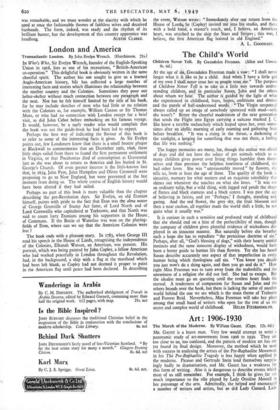London and America
Transatlantic London. By John Evelyn Wrench. (Hutchinson. 21s.)
IN Who's Who, Sir Evelyn Wrench, founder of the English-Speaking Union in 1918, lists as one of his recreations, " British-American co-operation." This delightful book is obviously written in the same cheerful spirit. The author has not sought to give us a learned Anglo-American history, bin has collected a large number of interesting facts and stories which illuminate the relationship between the mother country and the Colonies. Sometimes they pour out helter-skelter without much connection between one paragraph and the next. Nor has he felt himself limited by the title of his book, for he may include sketches of men who had little or no relation with the Colonies as, for example, William Caxton or Sir Thomas More, or who had no connection with London except for a brief visit, as did John Cabot before embarking on his famous voyage. It would, however; be a surly reader who would complain that the book was not the guide-book he had been led to expect.
Perhaps the best way of indicating the flavour of this book is to refer to some of the interesting facts it gives. As Sir Evelyn points out, few Londoners know that there is a small bronze plaque at Blackwell to commemorate that on December 19th, 1606, three little ships sailed from there to found the first permanent settlement in Virginia, or that Pocahontas died of consumption at Gravesend just as she was about to return to America and lies buried in St.. George's Church. Of even greater interest is the little-known fact that, in 1634, John Pym, John Hampden and Oliver Cromwell were proposing to go to New England, but were prevented at the last moment from doing so. The whole course of English history would have been altered if they had sailed.
Perhaps no part of this book is more valuable than the chapter describing the pre-Revolution days. Sir Evelyn, an old Etonian himself, points with pride to the fact that Eton was the alma mater of George Grenville of Stamp Act fame, of Lord North and of Lord Cornwallis who capitulated at Yorktown, and that North was said to count forty Etoniani among his supporters in the House of Commons. If the Battle of Waterloo was won on the playing- fields of Eton, where can we say that the American Colonies were lost ?
The book ends with a pleasant-story. In 1783, when George III read his speech in the House of Lords, recognising the independence of the Colonies, Elkanah Watson, an American, was present. His portrait, which was being painted by John Copley, a fellow American who had worked peacefully in London throughout the Revolution, had, in the background, a ship with a flag at the masthead which had been left blank, as Copley had not deemed it proper to paint in the American flag until peace had been declared. In describing the event, Watson wrote: "Immediately after our return from the House of Lords he (Copley) invited me into his studio, and there with a bold hand, a master's touch, and, I believe, an American heart, was attached to the ship the Stars and Stripes ; this was, I believe, the first American flag hoisted in old England."
A. L. GOODHART.






































 Previous page
Previous page